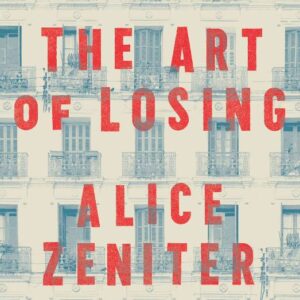“It takes a long time for a country to reemerge from silence, especially a country like Algeria.”
“The Art of Losing” chronicles the Algerian War of Independence from France through one family’s covert narrative. In her novel, Alice Zeniter fills the void of silence, weaving through a history meticulously reduced to a set of ellipsis punctuated with the occasional trivial remarks. Despite strives to stifle the past, alongside the shame and grief it brought, the family’s brush with colonialism and its violent impacts cast unwavering shadows.
Algeria subtly pervaded the intimate sphere of Naïma, the daughter of an Algerian father and French mother. While her name, black hair, and dark complexion are visible tokens of her North African lineage, Naïma’s paternal lineage does not extend beyond the narrow confines of her grandmother’s home in Pont-Féron, a French municipality. A restless Naïma thus endeavors to unearth her familial past buried beneath generations of calculated silence and unutterable secrets. Naïma’s paternal history is narrated in three parts; it commences with her grandfather’s, Ali, narration, transitions to her father’s, Hamid, and concludes with Naïma’s account.
Across the Mediterranean, a young Ali resides in Kabilya, a mountainous region of Algeria adorned with lush slopes and olive groves. His belief system is straightforward. He accepts mektoub, trusting that some divine, otherworldly force has already written history. His life is merely a collection of predetermined actions, revealing itself with time. For a while, mektoub served Ali well. In the spring following his military service, Ali, now in his 20s, and his two younger brothers found an oil press amid floodwaters. This simple device, a token of fate, blessed Ali and his family with luxuriant olive groves and a consequential lucrative career. Following two failed marriages, Ali weds a young woman, referred to as Yema, who births his son, Hamid. However, as the Algerian National Liberation Front (FLN) advances strides against French colonial rule, Ali’s good fortune comes under threat. Haste judgments and surreptitious collaborations pronounce Ali a harki, the name given to Algerians who aided France during the war, coercing him and his family into exile following Algeria’s independence.
Ali and his family board the ship transporting them from Algiers to France. A desperate Ali absorbs the Algerian landscape across from him. However, the labyrinthine streets and unfamiliar houses spread throughout the Algerian capital distort his mental image. It bears no resemblance to his hometown, yet it is the scene that a young Hamid will cling to. As the family moves from refugee camps to housing projects, Hamid will remember the white villas, historic structures, and winding roads at the mention of his birth country. He never returns to Algeria, remaining in France since arriving at the Rivesaltes camp.

 The second part of “The Art of Losing” follows Hamid from his adolescence to the later years of his adulthood. Gaps of silence puncture his ties to Algeria, his father refusing to reveal why they suddenly moved across the Mediterranean. Failed attempts to unveil his family’s past drive Hamid further away. He endeavors to reinvent himself away from his family, the endless string of responsibilities, and their silence.
The second part of “The Art of Losing” follows Hamid from his adolescence to the later years of his adulthood. Gaps of silence puncture his ties to Algeria, his father refusing to reveal why they suddenly moved across the Mediterranean. Failed attempts to unveil his family’s past drive Hamid further away. He endeavors to reinvent himself away from his family, the endless string of responsibilities, and their silence.
The third and final part of “The Art of Losing” returns to Naïma. She works at an art gallery in Paris. Naïma does not know much about Algeria, her father’s birthplace, besides her family’s modest collection of sepia-toned photographs. She has no desire to visit her ancestral land, reiterating the “speech” she heard her father rehearse countless times when questioned about Algeria:
“My father planned to take me and my sisters there when we were old enough. But in 1997, my cousin and his wife were killed at a fake roadblock and my father changed his mind. He said he’d never go back to the bled [country]” (p. 398).
Nevertheless, Naïma’s boss sends her to Algeria to gather art material for an exhibition. Eager yet reluctant, Naïma sets off across the Mediterranean, where she slowly “projects words” onto her family’s silence (p. 420). She unravels her grandfather and father’s past, referring to old texts and articles to fill in the unanswered gaps.
Alice Zeniter does not narrate “The Art of Losing” “in the manner of a coming-of-age novel” (p. 431). She recognizes that colonial recovery is not a linear process. It never ends. Victims like Naïma continuously unfurl new truths and realities. Throughout the novel, Zeniter remains mindful of the silence, allowing the reader to fill its void with the novel’s gradual influx of information. She weaves historical events within the fictitious tale. Zeniter captures the Algerian War of Independence, colonialism, and their impacts with frankness and without glamor, leaving the reader with the sting of reality.
Discussion Questions:
- “The Art of Losing” traces three generations of one family. Throughout each narrative, xenophobia is a recurring theme. Discuss the similarities, if any, between the manifestations of xenophobia across each generation.
- How does the novel capture the role of North African women?
- Throughout “The Art of Losing,” Alice Zeniter mentions this idea of silence. Discuss it. What does this mean in the context of the novel? How does “silence” manifest in current and historical events?
- On page 240, the narrator explains Hamid’s alternate belief system to Ali’s idea of mektoub. Which do you agree with most?
- Who do you think the narrator was? Why do you think Zeniter kept them anonymous?


